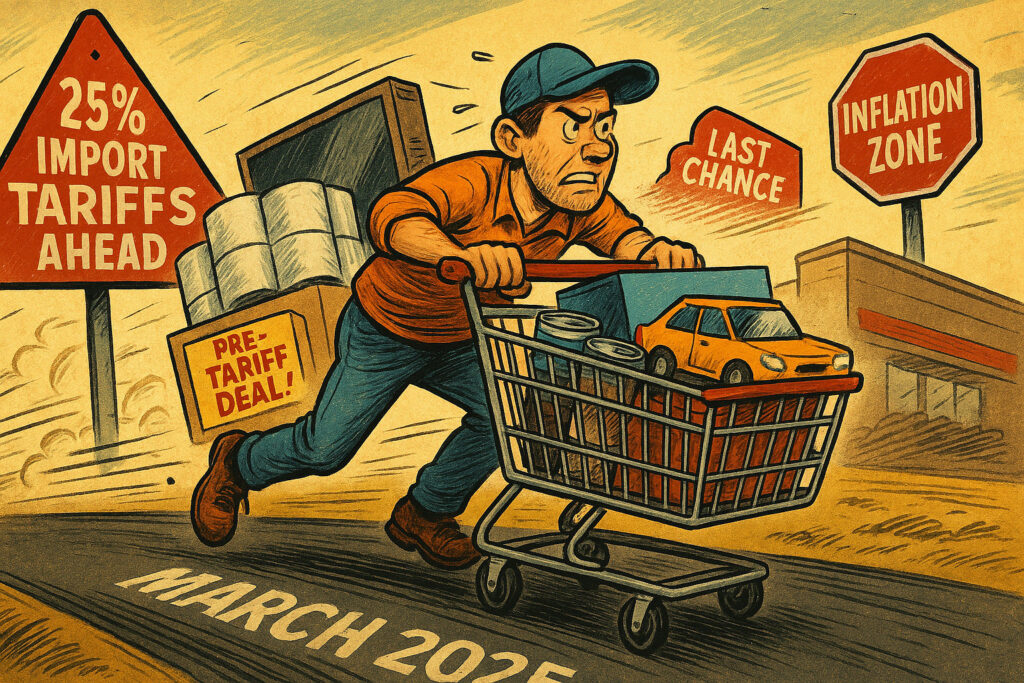Introduction
Despite a challenging economic backdrop, U.S. retail sales data for March 2025 defied expectations, rising significantly more than economists anticipated. The consumer-driven surge underscores the American public’s resilience and willingness to spend, even amid inflation, looming tariffs, and growing macroeconomic concerns.
March Retail Sales: A Closer Look
According to the U.S. Census Bureau, retail sales for March rose by 1.2% month-over-month, sharply beating the 0.6% expected by analysts. Compared to March 2024, sales climbed 3.4% year-over-year.
A standout contributor was the automotive sector, where sales skyrocketed amid consumer anxiety over the Biden Administration’s proposed 25% import tariffs on foreign vehicles. Anticipation of price hikes led to a surge in car purchases, especially Japanese and European brands.
Warehouse club retailers like Costco also benefited, reporting an 8.6% annual increase in total sales. A sudden rise in bulk-buying was seen in the days before March 10th — dubbed “Liberation Day” by media due to the incoming wave of protectionist tariffs.
Consumer Behavior Amid Inflation and Tariff Fears
Despite stronger spending, consumer sentiment has trended downward. The University of Michigan’s Index of Consumer Sentiment dropped to 64.7 in February, down from 71.7 in January, the sharpest monthly fall since mid-2022.
Still, consumers are proving selective in their cutbacks. A PYMNTS consumer survey revealed:
- Only 5.1% of consumers would cut manicures or salon visits if prices rise.
- Just 2.9% would scale back spending on children’s activities.
- Spending on streaming services and dining out has declined, but wellness and childcare-related expenses remain relatively protected.
This suggests that while consumers feel financial pressure, they continue prioritizing small luxuries and family essentials.
The Rise of the Secondhand Economy
The resale and thrift market has boomed in early 2025, driven by both financial necessity and cultural shifts.
Online resale platforms like ThredUp, Poshmark, eBay, and Facebook Marketplace reported double-digit growth in user engagement and GMV (gross merchandise volume). Analysts attribute this to:
- Consumer adaptation to high inflation.
- Social media trends glamorizing “thrift hauls.”
- Increased environmental awareness.
As one TikTok influencer put it: “Pre-owned is recession-proof chic.”
Credit Spending and the Banking Sector
U.S. banks are seeing the benefits — for now. Bank of America’s Q1 earnings jumped 11% YoY, aided by:
- A 4% increase in credit card volume.
- Rising interest income.
- Greater demand for personal installment loans.
However, financial institutions are issuing caution. Credit delinquencies have ticked slightly upward, with early-stage card delinquencies rising to 2.1% from 1.7% a year ago.
Business Strategy Shifts
Retailers are rapidly adapting to meet consumer needs. Major strategies include:
- “Everyday Low Prices” initiatives from Walmart, designed to lure price-conscious households.
- Amazon’s increased promotion of Warehouse Deals and Renewed Items.
- Upscaling and streamlining loyalty programs.
- Expanding Buy Now, Pay Later (BNPL) options across all price points.
Luxury retailers, however, are struggling. Brands like Burberry and Tiffany have reported slower U.S. sales, with consumers increasingly favoring value and practicality over prestige.
Forecast: What Lies Ahead?
Despite March’s strong figures, the National Retail Federation (NRF) expects retail growth to cool to between 2.7%-3.7% for the full year 2025, a modest downgrade from 2024’s 3.6% expansion.
Key risks:
- Persistent inflation from tariff-driven cost pass-throughs.
- Softening labor market expectations in Q2.
- Possible Fed rate hikes if inflation ticks up again.
That said, the NRF remains optimistic, citing low unemployment, steady real wage growth, and household savings buffers from 2020–2021 as stabilizing forces.
Conclusion
The March 2025 retail sales data reaffirms one key truth: the American consumer remains the engine of the U.S. economy, even under stress. With strategic adaptation from businesses and continued vigilance from policymakers, consumer resilience may continue to buoy the economy through uncertain waters.
This article reflects financial data and sentiment as of March 15, 2025. dynamics closely to navigate the evolving economic landscape.
